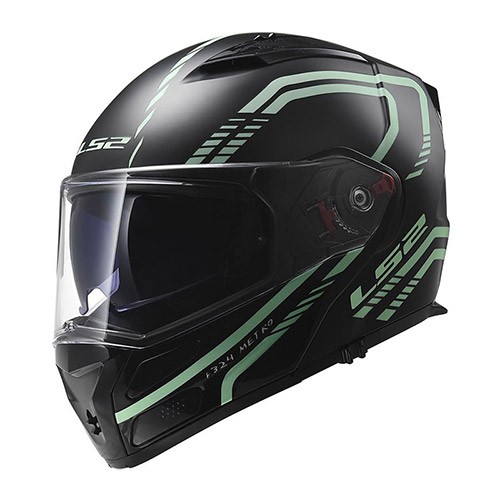
Let’s clear the air right off the bat with this one: This is *not* a crash-tested review, though I can understand why you would think so after I wrote about my recent experiences tumbling down the road in the Forcite MK1 helmet and Alpinestars’ own GP Force Chaser entry-level suit. While it’s never a great time to crash a motorcycle, the timing of those experiences brings a great deal of context to the latest in safety innovation by Alpinestars: the Tech-Air 10 airbag system.
The latest in Alpinestars Tech-Air protection, the Tech-Air 10 takes airbag protection all the way down to your hips.
| Aesthetics | 7/10 | Protection | 10/10 | Comfort | 9/10 |
| Value | 9/10 | Weight | 8/10 | Innovation | 10/10 |
| Quality | 8/10 | Options | 7/10 | Weather | 9/10 |
| Desirability | 8/10 | Editor Score: 85% | |||
+ Highs
|
– Sighs
|
Taken straight from the MotoGP paddock, Tech-Air is Alpinestars’ proprietary fully self-contained airbag system. Tech-Air 10 is the new flagship in the Tech-Air range which currently (as of this writing) includes the Tech-Air 5, which can be worn inside any appropriately fitting jacket or suit, and the Tech-Air 3 – an airbag vest that can be worn inside *or outside* a jacket – due for release in Fall 2022. For the dirt riders, Alpinestars is also developing the Tech-Air Off-Road, set for release in early 2023. Technically speaking, the Tech-Air Race, the first mass-produced airbag from Alpinestars, is still available but will be phased out in the coming seasons (but Alpinestars will still support it long after that).
What separates the Tech-Air 10 from the others, including airbags from other companies, is its airbag coverage area now extends down to the hips – a feature I wish I had when I fell down in the GP Force Chaser suit. All other systems on the market currently only cover the upper body to varying degrees. All of the Tech-Air systems, including the Tech-Air 10 provide full airbag protection for the shoulders, collarbones, chest, and back. With the exception of the Tech-Air 3, an integrated CE Level 2 back protector is integrated into the system, giving both active (airbag) and passive protection for your back.
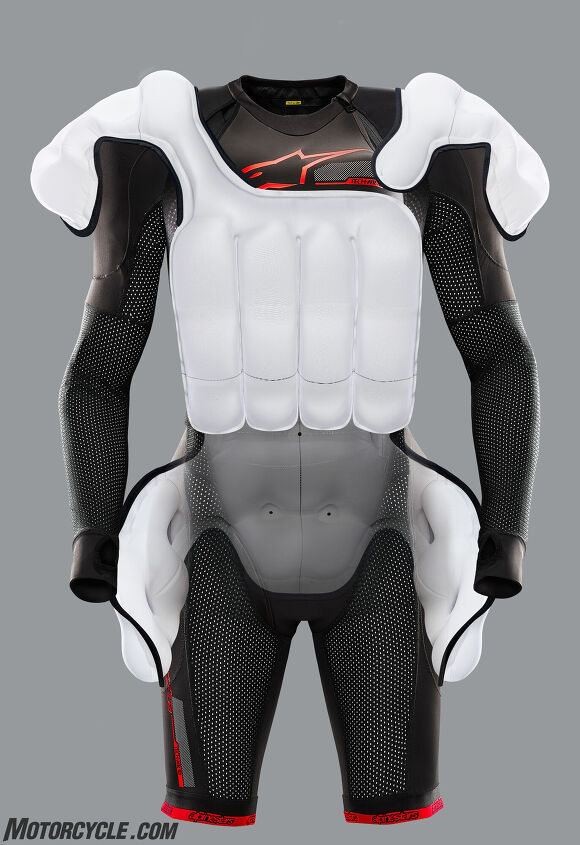
To date, every airbag system on the market has varying levels of coverage that extend down to the waist. The Tech-Air 10 goes further and gives you coverage all the way to your thighs, an area often making a hard impact with the ground. Compared to traditional passive hard impact protection, Alpinestars’ impact testing has shown the Tech-Air system can reduce up to 95% of the impact force that’s transferred to the body.
How It Works
As you can see from these pictures, the entire thing looks like a bulked-up base layer. That’s the point. Strategic zips and stretch panels connect and integrate the physical airbag and back protector to the rest of the base layer. Being able to separate the base layer from the airbag components means you can hand wash the base layer – because, you know, riding around in a cow suit is hot and sweat stinks. This is a departure from other Tech-Air systems which are basically vests you wear over your existing base layer. They can’t be washed.
If you’re familiar with the inner workings of any of the Tech-Air systems, then the 10 won’t be much of a revelation for you. There are three accelerometers – one at each shoulder and one in the back protector. Each of these accelerometers are monitoring and measuring data across three axes. A fourth sensor, a gyroscope, is also located in the back protector and is also working across three axes. Combine the four sensors with their combined tri-axial operation, and Alpinestars says the Tech-Air system has a total of 12 sensors monitoring your every move. You can judge the semantics of the number of sensors however you want, but rumor has it the dubious counting of sensors comes from the ongoing tit-for-tat between A-Stars and Dainese, the latter originally claimed to have more sensors in its D-Air system because it counted each axis as a sensor.
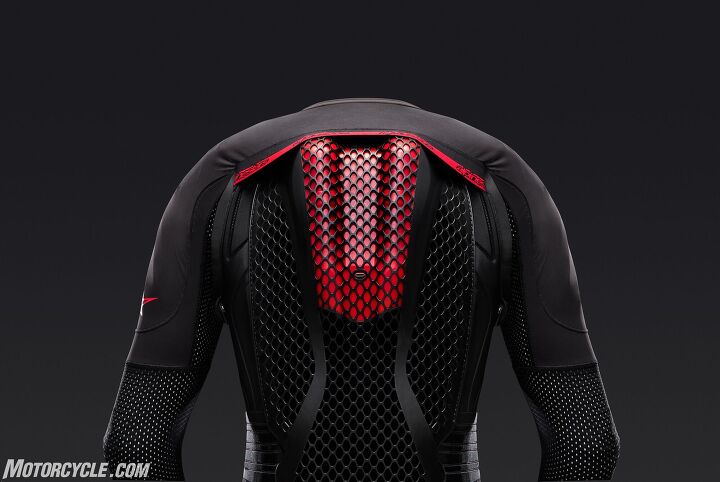
The brains of the Tech-Air system are housed in the red box in the middle of the back protector, itself a CE level 2 garment just like the entire airbag system.
Whichever number you want to go with, what really matters is how the system protects you. For the Tech-Air system, including the Tech-Air 10, the important bits are housed inside the back protector. This includes the ECU for the system, where all the processing from the 12 sensors (or four, depending on how you count them) happens thousands of times per second. When one sensor detects a crash scenario, it cross-references with the other three to verify (thousands of times per second, don’t forget). Once a loss of control warranting airbag protection (a minor slow-speed lowside may not need an airbag, for example) is detected, the system fires its two argon canisters and inflates the airbag in as little as 20 milliseconds for size XS, or as much as 40 milliseconds for size 3XL. To put that into perspective, the blink of an eye is 100 milliseconds.
Tech-Air die-hards might have noticed the TA10 deploys both of its argon canisters when needed, as opposed to the Tech-Air Race which deploys only one at a time, giving you two deployments. Because the TA10 has more physical airbag volume than the Race, both canisters are needed to fill the bag. Hence why you only get one deployment from the TA10. After a deployment, sending the Tech-Air 10 along with $199 back to Alpinestars (in Torrance, California for US customers) will get the canisters replaced. This assumes the airbag itself isn’t damaged. If it is – or if the airbag has been deployed three times – $399 will get you a full replacement of both canisters and airbag.
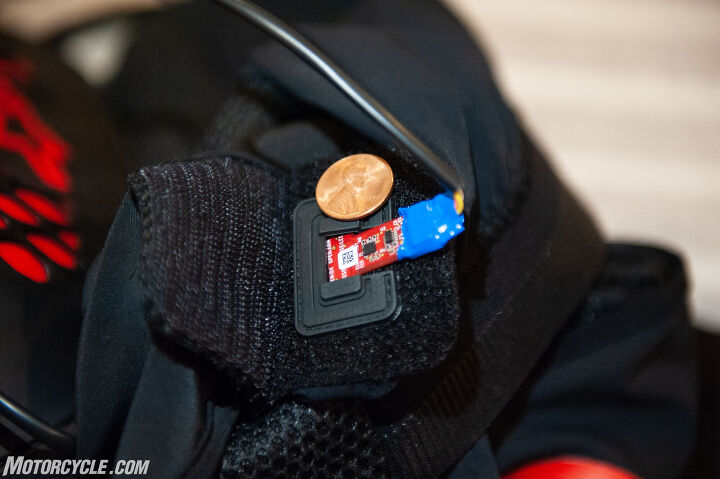
At each shoulder you’ll find an accelerometer, shown here housed inside of its Velcro sleeve. In case you’re wondering how small one of these accelerometers is, Abe Lincoln is shown for scale.
Getting back to how it works, algorithms for what defines a crash have been collected since 2004, and even today every time a Tech-Air system is sent back to Alpinestars after a deployment, that data is collected and then observed by Alpinestars’ AI to continually improve the system’s accuracy.
Over-the-air updates are regularly sent to each customer via the Tech-Air app. The app is the place where you can communicate with the system, see its charge status, and even record your ride to look at later or share with friends. Speaking of charging, a full charge takes about four hours from a dead battery and will get you approximately 24 hours of ride time. If you’re in a pinch, one hour of charging buys you six hours of ride time. A USB-C connection in the middle of the back protector makes the actual act of charging super easy.
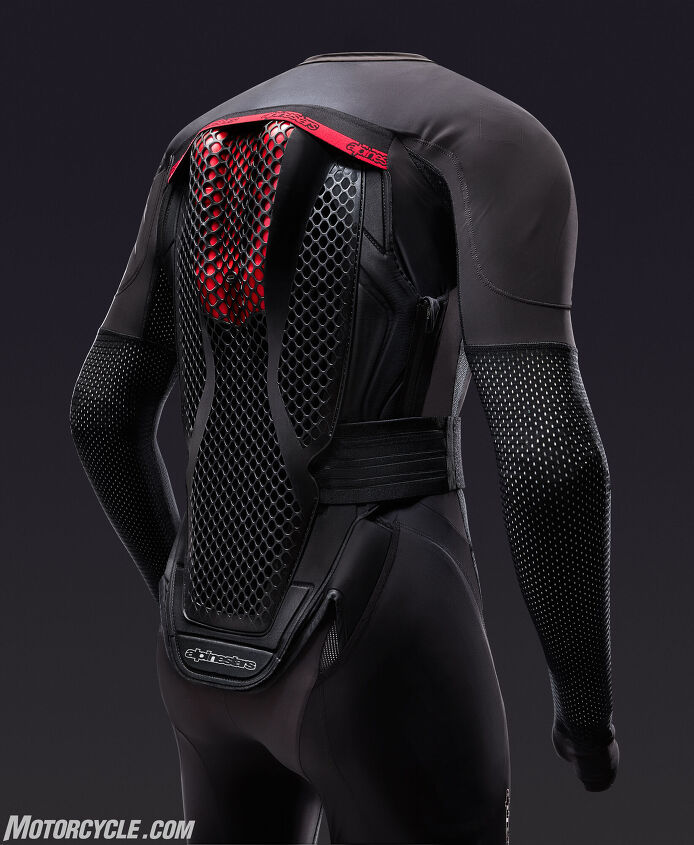
It’s hard to see in this photo, but in the center of the back protector, at the bottom of the red ECU housing, lies the USB-C charge port for the system. However, this view gives you an idea how far the back protector extends and how the system is incorporated into a base layer.
Because the system is entirely self-contained, you can wear the Tech-Air 10 under any suit, from any manufacturer, as long as it has roughly 4cm around the chest and 2cm around the thighs to accommodate the expansion of the airbag in a deployment. Obviously, Alpinestars would love if you bought one of its suits, but you don’t have to.
Like the Tech-Air 5, there’s also a Street setting for the TA10, switchable from the Tech-Air app. The primary difference being the system is active at all times in Street mode, even at a stop. In Race mode, the system won’t arm until you’re traveling approximately 37 mph (60 kph) for 10 seconds. This accounts for pit stops and other times at the track when you’re not moving. Obviously, on the street, you need protection at all times.
How It Fits
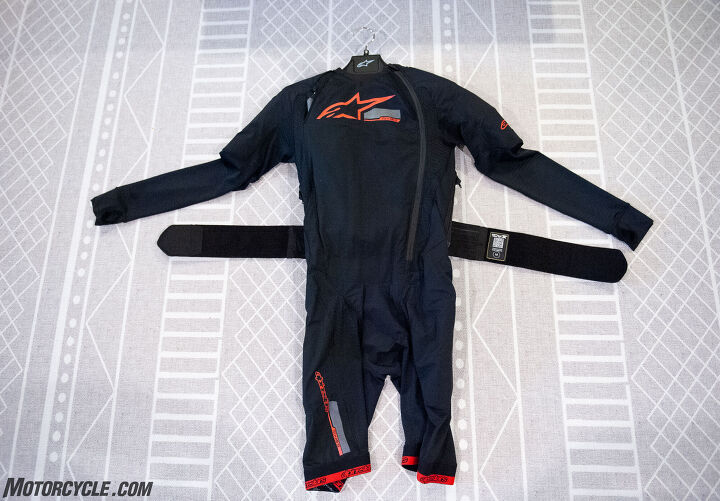
The Tech-Air 10 in its entirety. The offset zipper is the main entry point, and the Velcro waist band, once connected, arms the system.
We already mentioned that the Tech-Air 10 basically replaces the traditional base layer. At least for the top. The bottom portion extends halfway down your thigh, not too dissimilar to a pair of boxer briefs. Because of this, I choose to wear base layer bottoms to help both my suit and the TA10 slide off me when I’m done. Alpinestars says its alternative base layer chassis that extends down the length of the legs will be available in the Fall.
Nonetheless, putting the system on is as simple as unzipping the offset zipper on the side and slipping it on like a onesie; one leg at a time, and then the arms. The long sleeves feature thumb holes at the end to help you fit your arms inside your suit without bunching up the liner. If you have a little extra space in your glove, the neoprene material helps with sliding race gloves on and off, but I personally found the extra material around the hands more distracting than helpful, creating extra bulk inside an already tight-fitting glove.
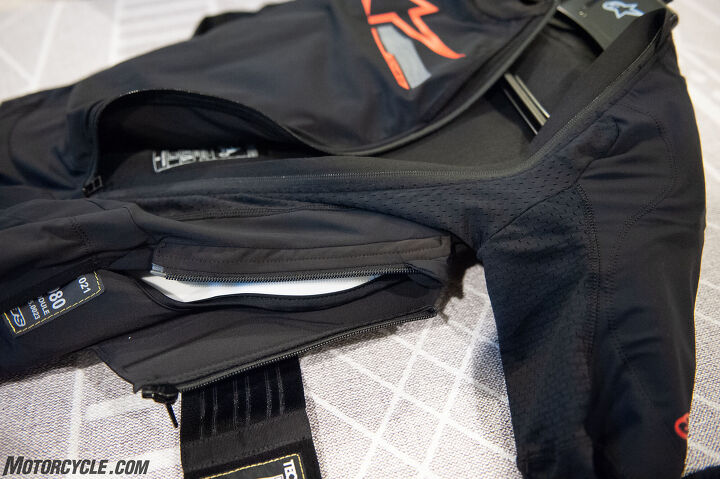
On each side of the Tech-Air 10, you’ll find smaller connection zippers. These are the airbag’s main attachment points to the base layer. You’ll have to undo a series of Velcro connectors and snaps up and down the system to fully remove the airbag (seen in white). On the left, where the Alpinestars tag is sewn in, is the physical airbag that extends into the thigh pocket of the base layer.
Once on, you can’t help but notice you’re wearing more than just your standard base layer. The airbag material itself fills up the chest section of the vest, and the airbag and extended-length back protector (compared to other Tech-Air systems) has your six covered. It doesn’t feel all that heavy when you’re wearing it either. At 5.29 lbs, distributed across your upper body, that’s basically nothing in my book. Especially for the amount of protection it offers.
Arming the system is as simple as connecting the kidney belt together. Attached to the kidney belt is the LED indicator, which can now be removed (if you choose) and placed in dedicated sleeve pockets in some compatible suits, the triple clamp of your motorcycle, or simply placed on a table. It connects to the rest of the system via Bluetooth and its light array simply tells you the status of the airbag. You can ride without it if you want, though it’s not recommended.
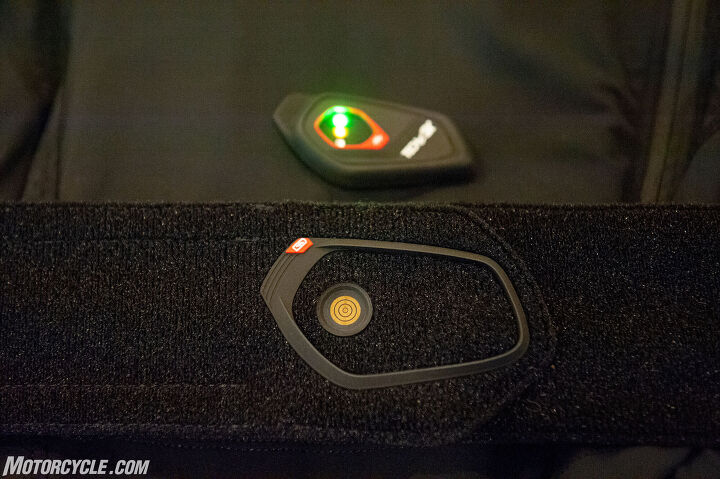
When the waistband is attached and the system is armed, the LED panel will light up to show you its status. With the Tech-Air 10, the LED panel is attached to the waistband in its own dedicated spot, but can be removed and placed in the suit sleeve, on the bike, or removed altogether (though you won’t know the status of the suit that way). The circular cut-out in the strap is the charge port for the LED panel when not in use.
For some, the real challenge comes when it’s time to put on your suit. It sounds easy, right? Just slip your arms and legs into the suit and away you go. Personally, other than being slightly careful when getting the suit over the thickest part of the back protector, putting on the Alpinestars GP Tech V4 suit wasn’t a problem. Maybe I’m just the prototypical generic male figure when it comes to Alpinestars sizing, but others I’ve talked to said they had a hard time putting their suit on over the Tech-Air 10. The main issue seems to be getting the suit up, over the upper back, and on the shoulders. Of the three riders I talked to, two of them had broad shoulders, to begin with, and the third has a longer-than-average torso. All three conditions make pulling the top half of a suit up and over a difficult task without some help.
Personally, once I had my suit on (which wasn’t too difficult in the first place for my scrawny frame), I forgot it was there. It didn’t impede my riding or affect how I moved around on the motorcycle. In fact, the biggest difference I noticed between the Tech-Air 10, the Tech-Air Race, and Tech-Air 5 was the amount of airflow I could feel as I was riding. Granted, I still wear an additional chest protector with those systems, which really blocks airflow, but there was a noticeable difference of cool air to my arms which permeated its way to my chest and core. Then, in between sessions when my suit isn’t all the way up, I could partially unzip the side entry zipper of the TA10 to allow more air to cool off my bare skin. Aside from the obvious advantages of having greater airbag coverage, I think the better cooling you get is a hugely underappreciated byproduct of the TA10 design.
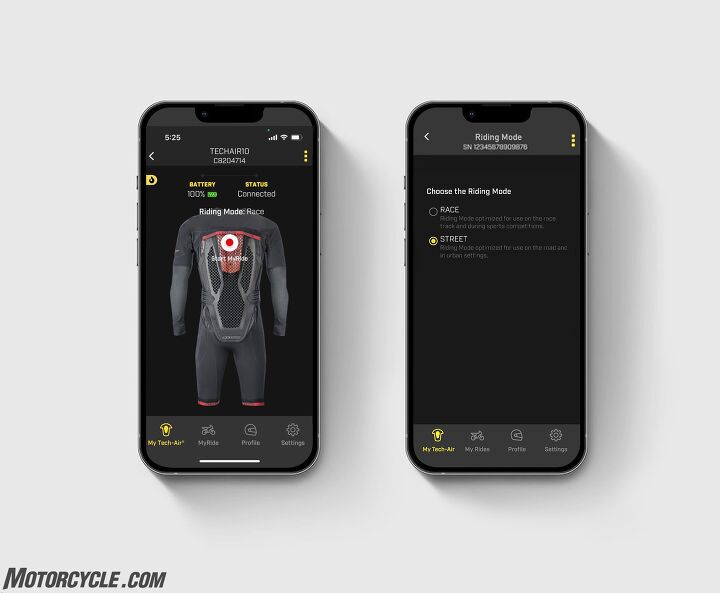
The Tech-Air app lets you communicate with the system and switch between Race and Street modes, among other things.
Of course, this unexpected high is countered by an unexpected low. Remember how those with shoulder girth had a hard time putting on their suits? Well, another issue many people complained about was taking the Tech-Air 10 off after they were done for the day. Even normal base layers can be a challenge to take off when you’re sweaty, but at least you can pull the upper half up and over your head. You can’t do that with the Tech-Air 10. With this, you’re hopefully flexible enough to reach behind your back and pull the opposing sleeve while wriggling, switching sides as you pull further and further until you’re able to pull an arm out completely. The other option is finding another person to pull the thing off you. If you’re in a hurry, or never skip back day at the gym, taking the TA10 off will have you seriously considering taking yoga classes for better flexibility.
The other option some revert to is wearing a traditional base layer top underneath the TA10 so it slides right off. This works, but it then adds another layer under your leathers – not what you want on a hot day. It also negates one of the biggest benefits of wearing the TA10 directly – airflow. Then again, if you’re riding on a cold day it might not be a bad idea.
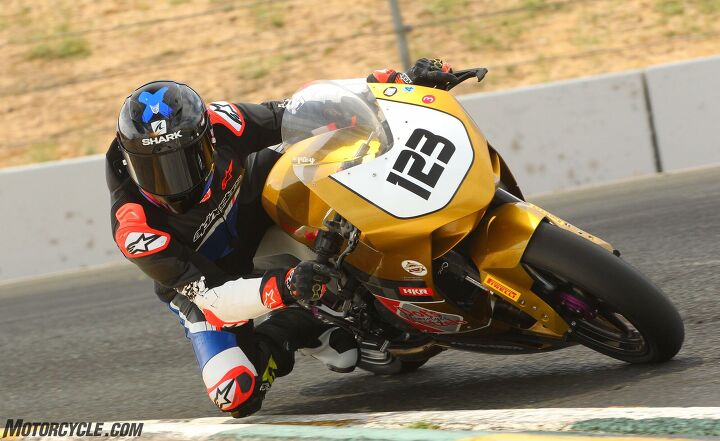
I didn’t have any complaints about the Tech-Air 10’s comfort while riding. In fact, I found its greater capacity for airflow to be better than other Tech-Air systems I’ve worn in the past.
During our ride day at the track, we didn’t get to sample the Tech-Air 10 in Street mode, though we imagine those having trouble pulling a suit up and over their shoulders will have an easier time putting on a jacket over the system. If you are considering the 10 for the street there are a few things to consider. First, Alpinestars doesn’t recommend wearing denim jeans or any riding pants with a belt. The belt will block (or at least limit) the thigh airbags from deploying or expanding. Dedicated riding pants with other means of fitting around the waist (Velcro, for example) are preferred.
Personally, there’s another reason why I’ll likely stick to wearing my Tech-Air 5 on the street instead of the 10. When nature calls and you have to make a bathroom run, you have to strip down in order to take care of business. There is a slit down there for guys to do their thing (we’re told the Tech-Air 10 is unisex), but if you’re wearing an additional base layer bottom it’s no use. And as we said before, taking the Tech-Air 10 off isn’t for someone in a hurry. It’ll be too late by the time you take everything off.
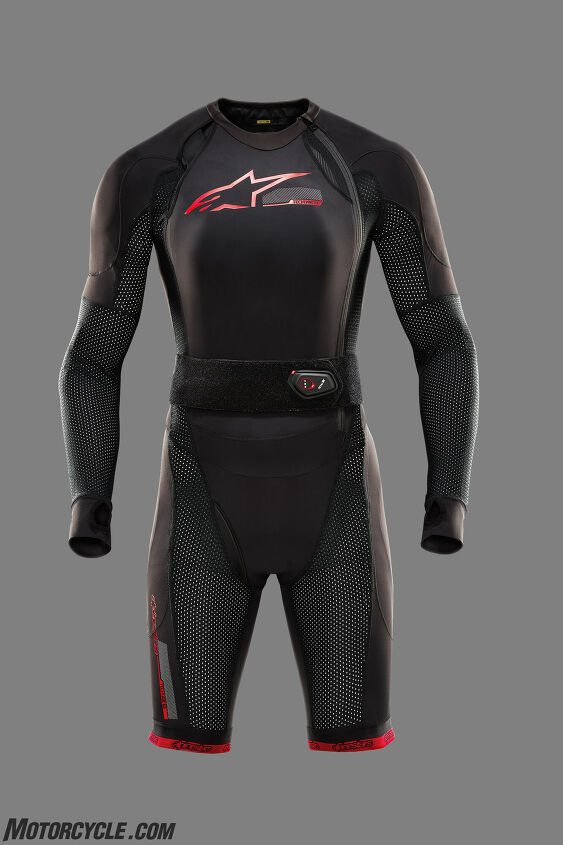
There is a slit down there, but will you be able to get to it in time?
Pushing The Envelope
For those who don’t know, after getting hit by a car while wearing the Tech-Air 5, I won’t ride without an airbag again. However, at least for right now, I don’t think the Tech-Air 10 is the airbag I need on the street. To me, the TA10’s strengths offer the greatest use and benefit for track riders. I know from a personal standpoint, I could have used the thigh protection in my most recent track crash, and the greater amount of airflow is an unexpected, but welcome, surprise. Being able to concentrate during a race or trackday with the confidence of knowing I’m as safe as possible with the Tech-Air 10 will allow me to focus on the next corner or the next pass without hesitation. For these reasons and more, the Tech-Air 10 is a welcome addition to the Tech-Air family.
The Tech-Air 10 is available now for $999.95 in sizes XS-3XL.
Shop for the Alpinestars Tech-Air 10 here
FAQ
Is a motorcycle airbag worth it?
That depends. Are you? I might be biased since I’ve personally experienced the protective qualities of airbags on both the track and the street, but I simply won’t ride a motorcycle without one. The cost of one is far less than the cost of a hospital bill. This review might be about a specific airbag system, but my personal belief is every rider should be wearing an airbag of some sort, no matter who makes it. Just as long as it’s a reputable company.
Why do motorcycles not have airbags?
Several reasons. Cost and complexity are two of them. Plus, an airbag on the rider is more effective than an airbag incorporated into the motorcycle. Unlike a car, where you’re strapped into the seat and your path of travel during an accident is relatively predictable, on a motorcycle every crash is different and there’s no telling where you’ll end up. Frankly, it just doesn’t make sense. Though Honda did experiment with airbags incorporated into the Gold Wing.
Are airbag vests reusable?
Yes. As far as we’re aware, every airbag on the market is reusable. The difference lies in the complexity of making them crash-worthy again. Many of the tethered airbags allow the user to repackage the CO2 cartridge themselves, whereas the electronic airbag systems need to be sent back to the manufacturer for repacking and refurbishing.
Additional Resources
Crash Tested: Alpinestars GP Force Chaser Leather Suit
Crash Tested: Alpinestars Tech-Air 5 Airbag System
Why I’ll Never Ride Without A Motorcycle Airbag Again
Best Motorcycle Airbag Jackets
MO Tested: In&Motion Airbag Vest
MO Tested: Dainese Smart Jacket Review
We are committed to finding, researching, and recommending the best products. We earn commissions from purchases you make using the retail links in our product reviews. Learn more about how this works.
Become a Motorcycle.com insider. Get the latest motorcycle news first by subscribing to our newsletter here.
